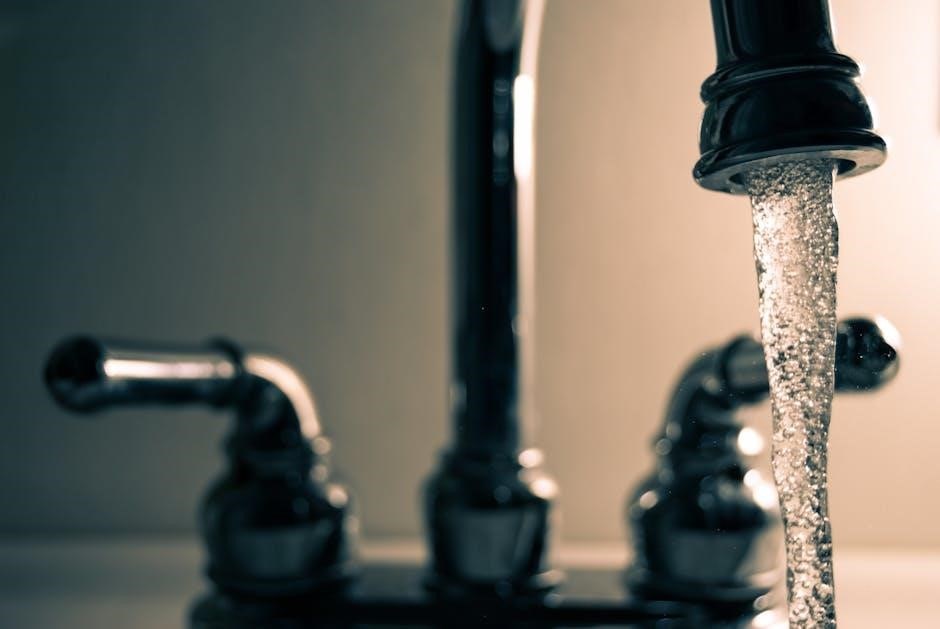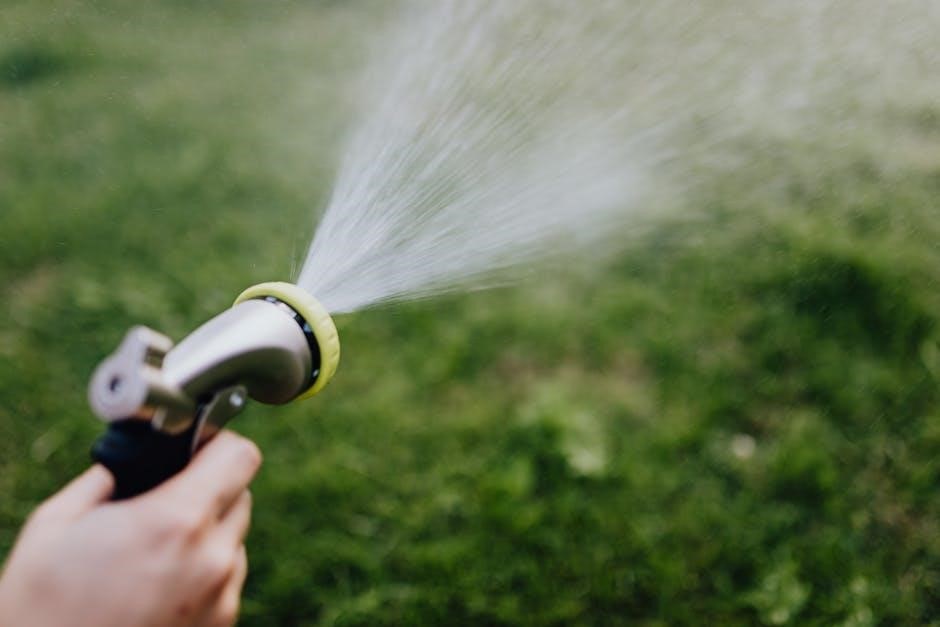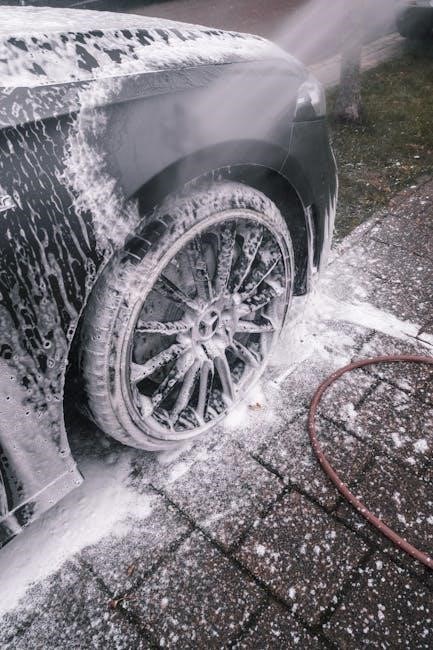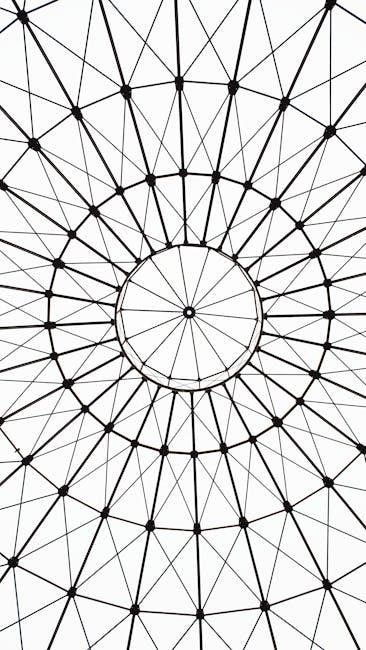
pressure washer nozzle size guide
Pressure washer nozzles are essential for optimizing cleaning tasks by adjusting water flow and pressure. They come in various sizes and spray angles, impacting performance. This guide helps you understand nozzle sizes, types, and how to choose the right one for your needs.

Understanding Nozzle Sizes
Nozzle sizes impact performance by regulating water flow and pressure; Smaller orifices increase pressure but restrict flow, while larger ones allow more flow but reduce intensity. Proper sizing ensures efficiency and safety, matching your pressure washer’s GPM and PSI specifications effectively.
Orifice Size Explained
The orifice size of a pressure washer nozzle is the diameter of the small opening through which water flows. Measured in inches, it determines the flow rate and pressure output. A smaller orifice restricts water flow, increasing pressure, while a larger orifice allows more water to pass through, reducing pressure. Proper orifice sizing is critical for optimizing cleaning efficiency and preventing damage to surfaces. The orifice size must align with the pressure washer’s gallons per minute (GPM) and pounds per square inch (PSI) ratings. For example, a smaller orifice (e.g., 0.020 inches) is ideal for high-pressure tasks like concrete cleaning, while a larger orifice (e.g., 0.040 inches) is better for low-pressure jobs like washing vehicles. Using the wrong size can lead to insufficient cleaning power or excessive wear on the equipment. Always refer to the manufacturer’s guidelines to select the correct orifice size for your specific needs.
Spray Angles and Their Uses
Spray Angles and Their Uses
Spray angles are a critical factor in determining the effectiveness of a pressure washer nozzle. They refer to the width of the fan-shaped water stream produced by the nozzle. Common spray angles range from 0° (a narrow, concentrated jet) to 65° (a wide, dispersed spray). Each angle serves specific purposes, making it essential to choose the right one for the job. A narrower angle, such as 15° or 25°, is ideal for heavy-duty cleaning tasks like stripping paint or cleaning concrete, as it delivers high pressure over a small area. Wider angles, such as 40° or 65°, are better suited for lighter tasks like washing cars or siding, as they cover more surface area with less intensity. Using the wrong spray angle can damage delicate surfaces or fail to remove stubborn dirt. Always match the spray angle to the task and surface type for optimal results. This balance ensures efficiency and prevents unnecessary wear on the equipment or damage to the material being cleaned.
Nozzle Color Codes
Nozzle color codes are a standardized system used to identify the orifice size and spray angle of pressure washer nozzles. Each color corresponds to a specific nozzle size and angle, making it easier for users to select the right one for their tasks. For example, a red nozzle typically has a 4.0 orifice size and a 0° spray angle, ideal for high-pressure, concentrated cleaning. Yellow nozzles (3.5 orifice size) offer a 15° angle, suitable for heavy-duty cleaning, while green nozzles (4.5 orifice size) provide a 25° angle for general-purpose cleaning. Blue nozzles (5.0 orifice size) deliver a 40° angle, perfect for lighter tasks like washing vehicles or siding. Black nozzles (5.5 orifice size) offer a 65° angle for delicate surfaces, and white nozzles (6.5 orifice size) provide a wide 80° angle for large areas. Purple nozzles (7.0 orifice size) are used for specialized tasks. The color coding system ensures quick identification and prevents mismatches, reducing the risk of surface damage or inefficient cleaning. Always match the color code to your specific cleaning needs for optimal results.

How to Choose the Right Nozzle

- Consider the surface type and cleaning task.
- Check the water pressure and flow rate of your pressure washer.
- Select a nozzle that matches your equipment’s specifications.
- Think about the desired spray angle for optimal coverage.
This approach ensures effective cleaning while protecting surfaces from damage.
Step-by-Step Guide to Nozzle Selection
Selecting the right pressure washer nozzle involves a few key steps to ensure optimal performance and surface protection. First, determine the cleaning task and surface type, as different nozzles are designed for specific jobs. Next, check your pressure washer’s maximum pressure (PSI) and flow rate (GPM), as these specs will guide your nozzle choice.
- Evaluate the surface: Delicate surfaces like glass or wood require wider spray angles (e.g., 60° or 80°), while concrete or heavy-duty cleaning needs narrower angles (e.g., 15° or 25°).
- Match the orifice size: Use a nozzle size chart to find the correct orifice diameter based on your washer’s PSI and GPM. A larger orifice increases flow but may lower pressure.
- Choose the spray angle: Wider angles cover more area but with less intensity, while narrower angles focus pressure for tough stains.
- Consider GPM: Higher flow rates require larger orifice sizes to avoid restricting water flow.
- Check color codes: Many nozzles use color coding to indicate orifice size and spray angle, simplifying selection.
- Test and adjust: If the nozzle feels too restrictive or pressure seems low, consider a larger size.

By following these steps, you can select the ideal nozzle for your pressure washer, ensuring efficient cleaning and surface safety.
Impact of Nozzle Size on Performance
The size of a pressure washer nozzle significantly impacts its performance, as it directly affects both water pressure and flow rate. A smaller nozzle orifice restricts water flow, increasing pressure, which is ideal for heavy-duty cleaning tasks like removing stubborn stains or cleaning concrete. Conversely, a larger nozzle allows more water to flow, reducing pressure but covering a wider area, making it suitable for delicate surfaces like wood or glass.

Using the wrong nozzle size can lead to inefficiencies. For example, a nozzle that is too small may create excessive pressure, potentially damaging surfaces, while a nozzle that is too large might not provide enough pressure for effective cleaning. The balance between pressure and flow rate is crucial for optimal performance.
Nozzle size also affects the spray angle. Narrower angles (e.g., 15° or 25°) are better for concentrated cleaning, while wider angles (e.g., 60° or 80°) are ideal for broader coverage. Matching the nozzle size to the task ensures efficient cleaning and prevents damage to both the surface and the pressure washer.

Pressure Washer Nozzle Size Chart
A pressure washer nozzle size chart is a valuable tool for selecting the right nozzle for your cleaning tasks. These charts typically outline the relationship between nozzle orifice size, spray angle, flow rate, and pressure. By understanding these relationships, users can optimize their cleaning performance.
The chart usually lists nozzle sizes (e.g., 1.0, 1.5, 2.0 orifice sizes in inches) alongside corresponding spray angles (e.g., 15°, 25°, 40°) and flow rates (measured in gallons per minute, GPM). It also shows the pressure range each nozzle is designed to handle, ensuring compatibility with your pressure washer’s specifications.
For example, a 2.0 orifice nozzle might deliver 4 GPM at 3000 PSI, creating a 60° spray angle, ideal for large surfaces. In contrast, a 1.0 orifice nozzle might deliver 2 GPM at the same pressure, producing a concentrated 15° spray for tough stains. Using the chart, you can match your nozzle to the job, ensuring efficiency and effectiveness.
Always refer to the manufacturer’s chart for your specific pressure washer, as performance can vary slightly between models. This guide helps you make informed decisions and achieve the best results for your cleaning projects.

Common Mistakes to Avoid
Common mistakes include using the wrong nozzle size, ignoring spray angles, and neglecting regular maintenance. Always match the nozzle to the task and ensure proper installation to avoid damage and optimize performance.
Using the Wrong Nozzle Size
Using the wrong nozzle size is one of the most common mistakes when operating a pressure washer. The incorrect nozzle can lead to inefficient cleaning, reduced performance, and potential damage to surfaces or the equipment itself; A nozzle that is too small may cause excessive pressure buildup, potentially harming the pump or hoses, while a nozzle that is too large might result in insufficient cleaning power. It’s essential to select a nozzle that matches the specific task and the pressure washer’s settings to ensure optimal results. Always refer to the manufacturer’s guidelines or a nozzle size chart to determine the appropriate size for your needs. Neglecting this step can lead to wasted time, increased water consumption, and subpar cleaning outcomes. By choosing the right nozzle size, you can maximize efficiency, protect your equipment, and achieve professional-grade results in your cleaning projects.
Ignoring Spray Angles
Ignoring spray angles when using a pressure washer can lead to ineffective cleaning and potential damage to surfaces. Spray angles, measured in degrees, determine the width and intensity of the water stream. Narrow angles (e.g., 0°, 15°) are ideal for heavy-duty tasks like stripping paint or cleaning concrete, while wider angles (e.g., 25°, 40°) are better suited for lighter tasks such as washing cars or siding. Using the wrong angle can result in uneven cleaning, wasted water, or even surface damage. For instance, a narrow angle on a delicate surface can etch or gouge materials, while a wide angle on a tough stain may fail to remove it effectively. It’s crucial to match the spray angle to the task at hand to ensure safety and efficiency. Always consult a nozzle size chart or manufacturer’s guidelines to select the appropriate spray angle for your pressure washer. By doing so, you can achieve better cleaning results and protect the surfaces you’re working with.

Different Types of Nozzles
Pressure washers use various nozzles to suit different tasks. Standard nozzles are versatile for everyday cleaning. Turbo nozzles provide intense cleaning power, while rotary nozzles handle large areas efficiently. Each type offers unique benefits for specific applications.
Standard Nozzles
Standard nozzles are the most commonly used and versatile option for pressure washers. They are designed for general cleaning tasks and are ideal for homeowners and professionals alike. These nozzles typically feature fixed or adjustable spray angles, allowing users to customize the water flow for different surfaces. The orifice size of standard nozzles varies, influencing the water flow rate and pressure output. A smaller orifice restricts water flow, increasing pressure, while a larger orifice allows more water to flow, reducing pressure but covering more area quickly. Standard nozzles are suitable for cleaning driveways, sidewalks, decks, and siding. They are also effective for lighter tasks like washing cars or outdoor furniture. Their durability and ease of use make them a popular choice. However, for heavy-duty cleaning or specialized jobs, other nozzle types may be more effective. Always choose a standard nozzle that matches your pressure washer’s specifications for optimal performance.
Turbo Nozzles
Turbo nozzles are a high-performance option designed for heavy-duty cleaning tasks. They feature a unique rotating spray pattern that creates a cone-shaped water flow, which is more aggressive than standard nozzles. This design allows for faster and more efficient cleaning of tough stains, grime, and dirt on surfaces like concrete, driveways, and heavy machinery. Turbo nozzles are ideal for professionals or users who need to tackle stubborn dirt and grime. They are also effective for stripping old paint or preparing surfaces for new coatings. One key advantage of turbo nozzles is their ability to handle higher pressure and flow rates, making them suitable for industrial or commercial use. However, they can be too harsh for delicate surfaces, so caution is advised. Turbo nozzles are a popular choice for those who need maximum cleaning power and efficiency. Always ensure your pressure washer is compatible with turbo nozzles, as they may require higher PSI to function properly. This makes them a valuable addition for tough cleaning jobs.
Rotary Nozzles
Rotary nozzles are another popular type of pressure washer nozzle, known for their unique spinning water jet design. These nozzles create a rotating or pulsating water flow, which enhances cleaning efficiency by covering a wider area more effectively. They are particularly useful for large, flat surfaces like driveways, sidewalks, and decks. The spinning action helps remove dirt and grime more aggressively than standard nozzles, making them ideal for heavy-duty cleaning tasks. Rotary nozzles are also designed to reduce streaks and provide a more even clean. They are often preferred by professionals due to their durability and versatility. When using rotary nozzles, it’s important to ensure your pressure washer is compatible with their operating pressure and flow rate. They are a great option for users who need a balance between power and precision. Rotary nozzles are a valuable tool for tackling tough cleaning jobs efficiently and effectively. Always check compatibility before use to ensure optimal performance.

How to Use a Nozzle Size Calculator
Using a nozzle size calculator is a straightforward process that helps you determine the ideal nozzle size for your pressure washer. These tools are designed to ensure optimal performance by matching the nozzle to your machine’s specifications. To start, you’ll need to input key details about your pressure washer, such as its maximum PSI (pounds per square inch) and GPM (gallons per minute). Some calculators may also ask for the desired flow rate or orifice size. Once you enter this information, the calculator will provide recommendations for the most suitable nozzle size. Many calculators also offer additional features, such as spray angle suggestions or flow rate adjustments. By following the calculator’s guidance, you can ensure your pressure washer operates efficiently, delivering the best cleaning results. Regularly using a nozzle size calculator can save time and improve the effectiveness of your cleaning tasks. It’s a valuable resource for both professionals and DIYers alike, ensuring precise and reliable nozzle selection every time.
Selecting the right pressure washer nozzle size is crucial for achieving optimal cleaning results while maintaining equipment efficiency. Understanding nozzle sizes, spray angles, and color codes helps you make informed decisions tailored to your specific tasks. By avoiding common mistakes, such as using the wrong nozzle size or ignoring spray angles, you can ensure safer and more effective cleaning. Remember, the correct nozzle not only enhances performance but also extends the lifespan of your pressure washer. Whether you’re tackling heavy-duty projects or routine cleaning, choosing the right nozzle size is essential. Always consider your pressure washer’s PSI and GPM ratings, and don’t hesitate to use a nozzle size calculator for precise recommendations. With the right nozzle, you’ll achieve better results, reduce waste, and enjoy a more efficient cleaning experience. Taking the time to select the appropriate nozzle size ensures your pressure washer operates at its best, delivering the power and precision you need for any job.